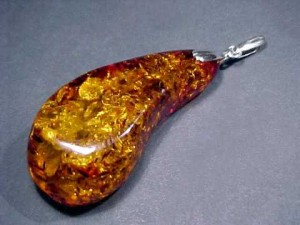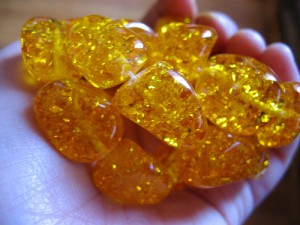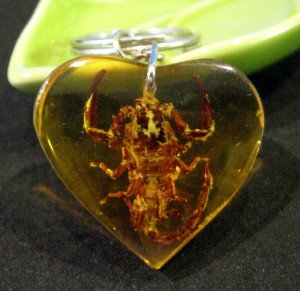 Fake amber and modern amber imitations focus on the replacement of the real natural materials and products. These imitated items are then sold at lower prices. Some jewelers and artisans prefer to work with fake pieces just to satisfy people's wishes.
Fake amber and modern amber imitations focus on the replacement of the real natural materials and products. These imitated items are then sold at lower prices. Some jewelers and artisans prefer to work with fake pieces just to satisfy people's wishes.
In terms of Baltic amber, this particular type of stone can be found along the Baltic Sea coasts and it is considered to be the finest and most appreciated amber stone in the world. Amber imitations started to appear soon after other materials proved they could replace Baltic amber, mostly after the 19th century. Surrogate materials include glass, other natural resins and plastics.
Nowadays, these imitations are accepted as raw semi-finished cheaper materials, similar in appearance to the real thing, but with different chemical properties or other physical traits. Amber imitations are also produced all around the world, some containing high-tech plastics known as Baltic amber forgeries, which are extremely difficult to differentiate from real amber. Still, experts have found some ways to distinguish real stones from fake ones, thanks to their professional expertise and years of experience. Simple methods include sinking the pieces in salt solution, comparing amber's characteristics and critical assessments or scent tests after heating.
 Complex methods include detailed examination with regard to surface cracks, internal cracks known as “scales” or stone hardness. As A. Golloch says, modern imitations are so close to perfection that simple analytical methods fail to differentiate between real amber and fake amber. Scientists developed the so-called FT-IR Spectroscopy test for the infallible identification of Baltic amber – succinite. Under close examination, real amber reveals its Baltic curve in spectrum coupled with gas chromatography and electron microscopic features.
Complex methods include detailed examination with regard to surface cracks, internal cracks known as “scales” or stone hardness. As A. Golloch says, modern imitations are so close to perfection that simple analytical methods fail to differentiate between real amber and fake amber. Scientists developed the so-called FT-IR Spectroscopy test for the infallible identification of Baltic amber – succinite. Under close examination, real amber reveals its Baltic curve in spectrum coupled with gas chromatography and electron microscopic features.
When it comes to fake amber and modern amber imitations, these come in various types. The first one is Copal, a replacement chemically similar to the real material. Copal is a very young tree resin that contains succinic acid, also found in 8% of amber's surface. It has a sweet, soft smell of pines, as a result of chemical substances known as terpenes. This surrogate stone is frequently used in imitating inclusions by simply inserting organic residuals inside the material.
 But Copal is not the only replacement material. Artisans commonly use glass, because it can achieve the same look as real amber, although it is very easy to detect that the stone is a fake. The modern industry also uses fenolic resins. These are chemical substances used in amber beads production. It can come close to some interesting amber colors such as dark red, cloudy yellow or limpid and it achieves exact oval or round shapes, making the buyer believe the product was better polished or carved.
But Copal is not the only replacement material. Artisans commonly use glass, because it can achieve the same look as real amber, although it is very easy to detect that the stone is a fake. The modern industry also uses fenolic resins. These are chemical substances used in amber beads production. It can come close to some interesting amber colors such as dark red, cloudy yellow or limpid and it achieves exact oval or round shapes, making the buyer believe the product was better polished or carved.
Various plastics are also used as amber replacements. The most common ones are celluloid, casein and modern plastic. Celluloid or cellulose nitrate has a yellowish color, similar to real amber, making it extremely difficult to differentiate between real and fake. The good part is that the difference can be detected with the use of heat, as celluloid is solid and not combustible, so instead of diffusing a soft smell of burnt resin, it gives off the scent of burnt plastic. Moving on to casein, this plastic is made of milk, generating a turbid yellow color, and it weights more than real amber. It also, it gives off a scent of burnt plastic after the heating test. And let's not forget about modern plastic such as polyester or polystyrene used in fake amber and fake inclusion productions. Seen with the naked eye, it is hard to differentiate between the real thing and the surrogate material, mainly because you can obtain the same clear vivid colors and limpidity. You can, however, know it is a fake because falsified inclusions are usually bigger than real ones and clearly visible in the center of the stone. Again, if heated it diffuses a scent of burnt plastic.
So although there are thousands of fake amber and modern amber imitations out there, there is always a smart way to distinguish between them and the real amber stones and inclusions, because let's face it, it's hard to compete with nature's skill and creation.



